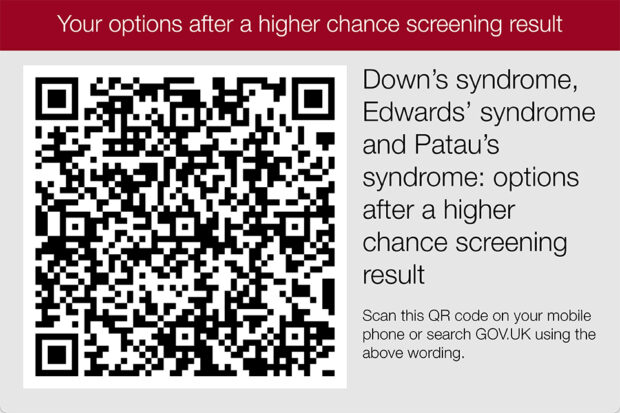
Non-invasive prenatal testing (NIPT) is being added to the existing NHS screening pathway for Down’s syndrome, Edwards’ syndrome and Patau’s syndrome. It is being offered as part of an evaluative rollout starting today (1 June).
NIPT can now be offered in most areas of England to women who receive a higher chance result from combined or quadruple screening done as part of the NHS antenatal screening pathway. A higher chance result is between 1 in 2 and 1 in 150. A lower chance result is a chance of 1 in 151 or above.
There is a short delay in rolling out NIPT for some maternity providers in England but we expect rollout to be completed from 1 July.
This project is complex for stakeholders, commissioners and maternity services, but the commitment and professionalism shown by everybody has helped us get to this point. We have been constantly questioned and challenged along the way – and rightly so. Our careful approach to stakeholder engagement has informed the whole project – particularly our public and professional information.
We would like to thank everybody involved – particularly the Down’s Syndrome Association (DSA), Down’s Syndrome Research Foundation (DSRF), SOFT-UK and Antenatal Results and Choices (ARC).
Information for women
Our aim is to provide women with information that helps them make an informed choice about screening and along the screening pathway.
Listening to lots of people’s views was critical to creating an NIPT version of Screening tests for you and your baby (STFYAYB), as well as specific NIPT resources. NHS colleagues in most of England should now use this NIPT information to support women in making their informed personal choices.
Providers in areas where NIPT is not yet offered should continue using the non-NIPT version of STFYAYB for women who accept screening and are due to have the combined or quadruple test before 1 July. Please contact the screening helpdesk with any questions.
New higher chance digital leaflet

We have developed a new resource to support women who have received a higher chance result from combined or quadruple screening. Down’s syndrome, Edwards’ syndrome and Patau’s syndrome: Your choices after a higher chance screening result contains information about:
- the 3 conditions
- women’s options
- NIPT
- diagnostic testing
- continuing support and care
- support organisations
You can use the QR code above to signpost women to this information.
The information is also available for people who cannot access the internet in a simple A4 printable PDF format that you can download and print off from the Simple PDF leaflets for printing page of the blog.
Data
The evaluation aims to answer the questions raised by the UK National Screening Committee (UK NSC) on:
- the choices women make
- the accuracy of NIPT in finding Edwards’ syndrome and Patau’s syndrome
- how often NIPT does not give a result
The performance of NIPT will be different in women who have had a higher chance result from combined or quadruple screening compared to those who have not had combined or quadruple screening. Better understanding of these differences will help us to:
- provide women with more information about how NIPT works within the NHS screening pathway
- make improvements as we move through the evaluative rollout
We would like to thank the genomic laboratories, maternity services and our colleagues in the National Congenital Anomaly and Rare Disease Registration Service (NCARDRS). The evaluation would not be possible without their support.
Education and training
We have collaborated closely with stakeholders to develop the national NIPT training materials.
NIPT workshops
More than 400 people attended one of the 6 NIPT workshops. Representatives from all maternity care providers in England were invited to attend and we asked participants to complete an evaluation survey.
The results of the survey were reassuring, with 91% of respondents saying the workshop met their needs, and 97% rating the workshops good or excellent. This hopefully means that maternity care providers feel confident about discussing NIPT with women so they can decide what’s right for them.
One participant told us:
It was an excellent workshop. Concise, informative and it prepared me for the rollout.
NIPT e-learning
More than 3,500 healthcare professionals have completed the NIPT e-learning resource since we started offering it back in October 2020. The aim of the resource is to help staff feel more confident discussing the updated care pathway with women and supporting their choices.
This comment from a participant of one of the NIPT workshops highlights the importance of the e-learning:
I am fairly new to screening (and NIPT) and the e-learning was really important. It helped me understand the NIPT workshop better.
If you have not worked through the resource yet, we recommend that you do so as soon as you can.
Other resources
We recently published the NIPT operational guidance on NIPT to support the offer of NIPT. Services should now be familiar with the updated Down’s syndrome, Edwards’ syndrome and Patau’s syndrome screening pathway.
We’ll continue blogging about NIPT as we work our way through the evaluative rollout, so do continue to keep an eye out for updates via the PHE Screening blog (search under the NIPT tag).
PHE Screening blog
The PHE Screening blog provides up to date news from all NHS screening programmes. You can register to receive updates direct to your inbox, so there’s no need to keep checking for new blogs. If you have any questions about this blog article, or about population screening in England, please contact the PHE screening helpdesk.